Present and future Köppen-Geiger climate classification maps at 1-km resolution
- PMID: 30375988
- PMCID: PMC6207062
- DOI: 10.1038/sdata.2018.214
Present and future Köppen-Geiger climate classification maps at 1-km resolution
Erratum in
-
Publisher Correction: Present and future Köppen-Geiger climate classification maps at 1-km resolution.Sci Data. 2020 Aug 17;7(1):274. doi: 10.1038/s41597-020-00616-w. Sci Data. 2020. PMID: 32807783 Free PMC article.
Abstract
We present new global maps of the Köppen-Geiger climate classification at an unprecedented 1-km resolution for the present-day (1980-2016) and for projected future conditions (2071-2100) under climate change. The present-day map is derived from an ensemble of four high-resolution, topographically-corrected climatic maps. The future map is derived from an ensemble of 32 climate model projections (scenario RCP8.5), by superimposing the projected climate change anomaly on the baseline high-resolution climatic maps. For both time periods we calculate confidence levels from the ensemble spread, providing valuable indications of the reliability of the classifications. The new maps exhibit a higher classification accuracy and substantially more detail than previous maps, particularly in regions with sharp spatial or elevation gradients. We anticipate the new maps will be useful for numerous applications, including species and vegetation distribution modeling. The new maps including the associated confidence maps are freely available via www.gloh2o.org/koppen.
Conflict of interest statement
The authors declare no competing interests.
Figures
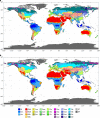
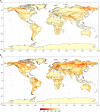
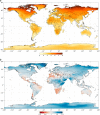
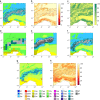
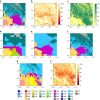
References
Data Citations
-
- Beck H. E., et al. . 2018. Figshare. https://doi.org/10.6084/m9.figshare.6396959 - DOI
References
-
- Köppen W. Das geographische System der Klimate, 1–44 (Gebrüder Borntraeger: Berlin, Germany, 1936).
-
- Köppen W. Die Wärmezonen der Erde, nach der Dauer der heissen, gemässigten und kalten Zeit und nach der Wirkung der Wärme auf die organische Welt betrachtet. Meteorologische Zeitschrift 1, 215–226 (1884).
-
- Rubel F. & Kottek M. Comments on: “the thermal zones of the Earth” by Wladimir Köppen. (1884). Meteorologische Zeitschrift 20, 361–365 (2011).
-
- Webber B. L. et al. Modelling horses for novel climate courses: insights from projecting potential distributions of native and alien Australian acacias with correlative and mechanistic models. Diversity and Distributions 17, 978–1000 (2011).
-
- Mahlstein I., Daniel J. S. & Solomon S. Pace of shifts in climate regions increases with global temperature. Nature Climate Change 3, 739–743 (2013).
Publication types
Associated data
LinkOut - more resources
Full Text Sources

